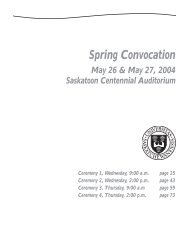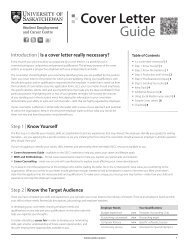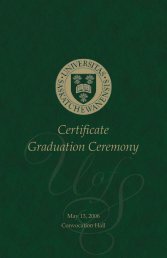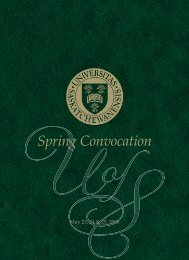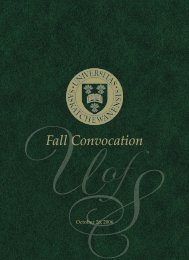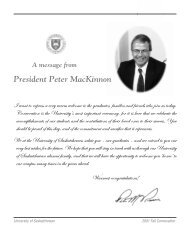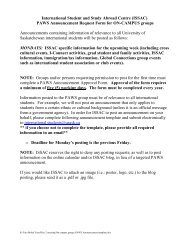Spring Convocation - Students - University of Saskatchewan
Spring Convocation - Students - University of Saskatchewan
Spring Convocation - Students - University of Saskatchewan
You also want an ePaper? Increase the reach of your titles
YUMPU automatically turns print PDFs into web optimized ePapers that Google loves.
Earned Doctor <strong>of</strong> Science<br />
JEREMY LEE<br />
Born and raised in Northern England,<br />
Jeremy Lee was awarded a scholarship<br />
in 1971 to study natural sciences at<br />
Cambridge <strong>University</strong> and received a<br />
B.A. in chemistry in 1974. Three years<br />
later, he completed a Ph.D. in<br />
pharmacology. His thesis title was The<br />
Binding <strong>of</strong> Antibiotics to DNA —<br />
research that marked the beginning <strong>of</strong><br />
a lifelong interest in the structure and<br />
function <strong>of</strong> nucleic acids.<br />
After spending four years working in a<br />
university biochemistry lab in<br />
Edmonton, Dr. Lee became a landed<br />
immigrant in 1980. In 1982, he moved<br />
to Saskatoon to take up a position at<br />
the U <strong>of</strong> S as assistant pr<strong>of</strong>essor <strong>of</strong><br />
biochemistry.<br />
His initial research focus was analysis<br />
<strong>of</strong> monoclonal antibodies that bind to<br />
proteins, DNA or RNA. By 1987, he<br />
had succeeded in preparing unique<br />
antibodies which bind specifically to<br />
three-stranded DNA, showing that the<br />
chromosomes <strong>of</strong> eukaryotes—the same<br />
broad group <strong>of</strong> organisms that includes<br />
humans—contained this unusual<br />
structure.<br />
In 1997, he was the first to convert an<br />
antibody that binds to RNA into a<br />
nuclease that cuts RNA into pieces by<br />
the modification <strong>of</strong> a single amino<br />
acid. But it was the unexpected<br />
discovery <strong>of</strong> another unusual DNA<br />
structure in 1992, called M-DNA,<br />
which has dominated his research for<br />
the last 15 years.<br />
M-DNA has a metal ion in the middle <strong>of</strong><br />
the DNA helix which causes the DNA to<br />
become a conductor <strong>of</strong> electrons rather<br />
than an insulator. With a diameter <strong>of</strong><br />
only two nanometers, M-DNA may be<br />
the smallest wire imaginable. Indeed a<br />
simple transistor with dimensions <strong>of</strong><br />
only 10 nanometres has been<br />
constructed in Dr. Lee’s lab.<br />
Potential applications include<br />
M‐DNA‐based diagnostic tools that<br />
would quickly yield information on<br />
genetic disease and bacterial<br />
infection—perhaps even providing<br />
answers to doctors before the end <strong>of</strong> a<br />
patient’s visit. Adnavance Technologies<br />
Inc. was founded in 2002 in order to<br />
exploit this possibility, with Dr. Lee<br />
serving as the company’s chief<br />
scientific <strong>of</strong>ficer.<br />
Dr. Lee is proud <strong>of</strong> the fact that he has<br />
never taken a biochemistry course in<br />
his life and yet has taught the subject<br />
for 25 years to medical and graduate<br />
students and in the undergraduate<br />
biochemistry program.<br />
He was honoured with the College <strong>of</strong><br />
Medicine basic sciences teaching<br />
award in 1990 and 1995. His love <strong>of</strong><br />
teaching is matched only by his dislike<br />
<strong>of</strong> PowerPoint and he can frequently<br />
be found walking around campus<br />
covered in chalk dust.<br />
<strong>University</strong> <strong>of</strong> <strong>Saskatchewan</strong> 26 <strong>Spring</strong> <strong>Convocation</strong> 2007



